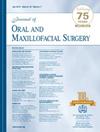局部切口与冠状切口治疗颧颌复合体骨折的影像学效果评价。
IF 2.6
3区 医学
Q2 DENTISTRY, ORAL SURGERY & MEDICINE
引用次数: 0
摘要
背景:颧骨腋窝复合体(ZMC)骨折通常采用局部或冠状切口治疗,每种方法都有其独特的优点和缺点。目的:本研究的目的是比较局部或冠状切口手术治疗颧骨骨折的成像测量结果。研究设计、背景、样本:本回顾性队列研究分析了兰州大学第二医院(2021 - 2023)手术治疗的ZMC骨折。纳入标准如下:患者有移位性骨折(≥1mm)并继发于创伤的颧骨部分旋转。排除病例如下:移位最小、资料不完整或影像不充分的患者。预测变量:主要预测变量是ZMC骨折的手术入路:局部或冠状切口。结局变量:主要结局变量为骨折修复质量。我们使用计算机断层成像测量了与解剖标志的双侧距离差异作为骨折修复的质量。骨折修复质量分级如下:2mm(一般)。协变量:年龄、性别、外伤机制、术前等待时间、ZMC骨折分型、眼部损伤、伴发其他颌面骨折。分析:采用t检验和χ2检验进行双变量分析。差异有统计学意义,P < 0.05。结果:纳入研究对象75例,平均年龄37±4岁,其中男性52例(69.3%),女性23例(30.7%)。局部切口40例(53%),冠状切口35例(47%)。手术入路(局部与冠状)和骨折修复质量之间存在统计学差异(P < 0.0001)。冠状切口枕骨大孔距颧面距离(0.78±0.62 mm)与局部切口枕骨大孔距(1.34±0.98 mm)差异有统计学意义(P = 0.003)。同样,从中线到颧骨表面的距离也有显著差异(冠状面:0.73±0.40 mm vs局部:1.38±1.21 mm;P = 0.005)和D-FZA(冠状:0.65±0.34 mm vs局部:1.29±0.81 mm;P < 0.0001)。结论及意义:在ZMC骨折手术中,局部切口可以达到满意的效果,同时避免了额外的切口。与局部切口相比,冠状切口提供准确的解剖复位和改善骨折重新定位的优势。本文章由计算机程序翻译,如有差异,请以英文原文为准。
Evaluation of the Radiological Results Between Local and Coronal Incisions in the Treatment of Zygomaticomaxillary Complex Fractures
Background
Zygomaticomaxillary complex (ZMC) fractures are commonly treated using either local or coronal incisions, each approach having distinct advantages and disadvantages.
Purpose
The purpose of this study was to compare treatment outcomes by imaging measurements in zygomatic fractures treated with local or coronal incision surgery.
Study Design, Setting, Sample
This retrospective cohort study analyzed surgically treated ZMC fractures at the Second Hospital of Lanzhou University (2021 to 2023). Inclusion criteria were as follows: patients had displaced fractures (≥1 mm) with zygomatic partial rotation secondary to trauma. Exclusions were as follows: patients with minimal displacement, incomplete data, or inadequate imaging.
Predictor Variables
The primary predictor variable was the surgical approach to the ZMC fracture: localized or coronal incision.
Outcome Variables
The primary outcome variable was fracture repair quality. We had measured the bilateral distance differences from anatomical landmarks as quality of fracture repair using computed tomography imaging. Quality of fracture repair was graded as follows: <1 mm (excellent), 1 to 2 mm (good), and >2 mm (general).
Covariates
The covariates included age, gender, trauma mechanism, preoperative waiting time, classification of ZMC fractures, eye injury, and accompanied other maxillofacial fractures.
Analyses
Statistical analyses were performed by t-test and the χ2 test for bivariate analysis. Statistical significance was set at P < .05.
Results
The study included 75 subjects with a mean age of 37 ± 4 years, comprising 52 males (69.3%) and 23 females (30.7%). Local and coronal incisions were used in 40 (53%) and 35 (47%) subjects, respectively. There was a statistically significant difference between surgical approach (local vs coronal) and fracture repair quality (P < .0001). There was a statistically significant difference in the distance of the foramen magnum to the zygomatic surface between coronal incision (0.78 ± 0.62 mm) and local incision (1.34 ± 0.98 mm) (P = .003). Similarly, significant differences were observed in the distance from the midline to the zygomatic surface (coronal: 0.73 ± 0.40 mm vs local: 1.38 ± 1.21 mm; P = .005) and distance of the foramen magnum to the zygomatic arch (D-FZA) (coronal: 0.65 ± 0.34 mm vs local: 1.29 ± 0.81 mm; P < .0001).
Conclusion and Relevance
The local incisions can achieve satisfactory outcomes in ZMC fracture surgery while avoiding additional incisions. Compared to local incisions, coronal incisions offer the advantage of accurate anatomical reduction and improved fracture repositioning.
求助全文
通过发布文献求助,成功后即可免费获取论文全文。
去求助
来源期刊

Journal of Oral and Maxillofacial Surgery
医学-牙科与口腔外科
CiteScore
4.00
自引率
5.30%
发文量
0
审稿时长
41 days
期刊介绍:
This monthly journal offers comprehensive coverage of new techniques, important developments and innovative ideas in oral and maxillofacial surgery. Practice-applicable articles help develop the methods used to handle dentoalveolar surgery, facial injuries and deformities, TMJ disorders, oral cancer, jaw reconstruction, anesthesia and analgesia. The journal also includes specifics on new instruments and diagnostic equipment and modern therapeutic drugs and devices. Journal of Oral and Maxillofacial Surgery is recommended for first or priority subscription by the Dental Section of the Medical Library Association.
 求助内容:
求助内容: 应助结果提醒方式:
应助结果提醒方式:


